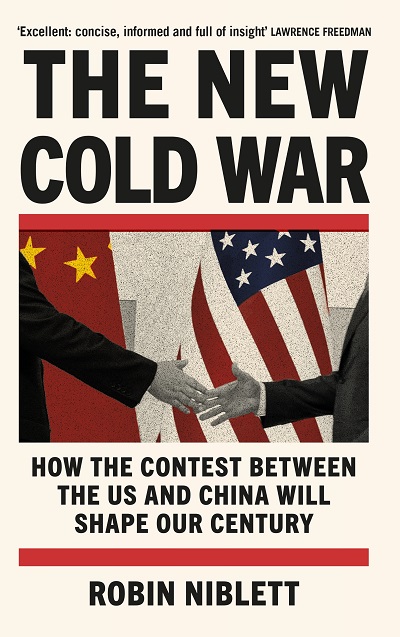Robin Niblett, a former director of British think tank Chatham House, has published a new book that has received high praise from notables such as Hillary Clinton, Kevin Rudd and Lawrence Freedman. The New Cold War: How the Contest Between the US and China Will Shape Our Century is a lucid and excellent guide to the state of play in international politics – reviewing the strengths and weakness of both sides, and the roles that emerging powers, international institutions and ideologies play in this new phase of superpower competition.
As things stand, the United States and China see each other in zero sum terms and are building capabilities and partnerships to balance the other. They are also deeply integrated economically: the world depends on components manufactured by China, which in turn needs the United States as an export market, while just as many American companies see China as central to their growth plans.

Russia’s invasion of Ukraine and US-China rivalry have prompted interesting policy shifts in the West. European powers have been, in recent years, wary of Moscow’s ambitions, while simultaneously deepening economic links with China. But Washington’s insistence on a joined-up Western approach, and the fear that the United States may reduce its commitment to Europe, has forced the latter to change course. The European Union currently designates China as a “systemic rival” and is taking steps to reduce dependence on the country.
Niblett points to the emergence of an “informal Atlantic-Pacific partnership” whereby “America’s transatlantic allies organised around NATO are interlinking with its main Pacific allies – Australia, Japan and South Korea – through a mix of new security and technological partnerships.” This is reflected in the AUKUS alliance and pledges by France, Germany and the United Kingdom to increase their military presence in Asia.
Both sides in the new Cold War and emerging powers are advancing their interests through multilateral groups and by building support in the Global South. The West has the G7, NATO, the EU, the Quad and the OECD. China exerts influence through the Shanghai Cooperation Organisation, BRICS, and the Asia Infrastructure Investment Bank.
The most striking aspect of Niblett’s book is that he continues to frame the new Cold War as a contest between democracies and autocracies.
Critics tend to dismiss Western rhetoric about democracy since promoting it in Iraq and Afghanistan failed spectacularly and because the United States arguably has a record of pushing democracy only when it does not clash with its strategic interests.
In this reckoning, these regimes cannot peacefully coexist because democracy threatens authoritarians by its very existence.
Niblett moves the debate beyond this objection by highlighting structural tensions between democracy and authoritarianism. The world, he argues, is divided between competing models of governance: between countries that protect individual rights, checks and balances, press freedoms and judicial independence; and regimes that fear democratic freedoms and privilege state power and national sovereignty over human rights and rule of law.
In this reckoning, these regimes cannot peacefully coexist because democracy threatens authoritarians by its very existence. Russian President Vladimir Putin doesn’t care as much about NATO expansion as he does the presence of democracies around him, which raise questions about his own regime. Taiwan is both unfinished business for the Chinese state and, as a democracy, an ideological threat to Beijing. And so Russia and China work to shape the international order in their own image by making common cause with illiberal regimes in Iran, Saudi Arabia, and those of other strongmen in Asia and Africa.
There is a strategic logic to forming new multilateral groupings and forging ties with developing countries, but there is also an intent to “build a more permissive international environment for their political system”. Niblett writes that what Putin and China’s President Xi Jinping want “is a world that is safer for autocratic forms of governance”. Russia thus works against “colour revolutions” in its periphery and supports coups in Africa, while China backs the junta in Myanmar and challenges the values underpinning the existing international human rights system.
Critics are liable to argue that this framing obscures the West’s own chequered record of backing democracy abroad. But it can be said that what open societies have, for all their faults, is the capacity for course correction since they allow a wider range of public debate on issues, in ways that autocracies do not.
Niblett’s argument prompts questions on where India under Narendra Modi figures in the schema of democracy and authoritarianism. India certainly has elections, but there is considerable evidence of democratic backsliding. It remains a strong voice for the Global South, but the BJP government’s instincts on internal checks and balances, and press and civil society freedoms are not in step with standard liberal democratic norms. Whether New Delhi now makes the world safer for illiberalism or fortifies the cause of democracy is an open question.
It is perhaps for that reason that Niblett proposes enlarging the G7 to a G9 including South Korea and Australia (leaving out India) as a group of democracies to coordinate their policies, pool their resources, and invest “together in their economic security and strategic resilience”.
Niblett makes a persuasive case of looking at world politics through a democracy lens. The prospect of a world led by (a returning) Trump, Putin, Xi, Modi and Erdoğan makes his thesis even more compelling.

